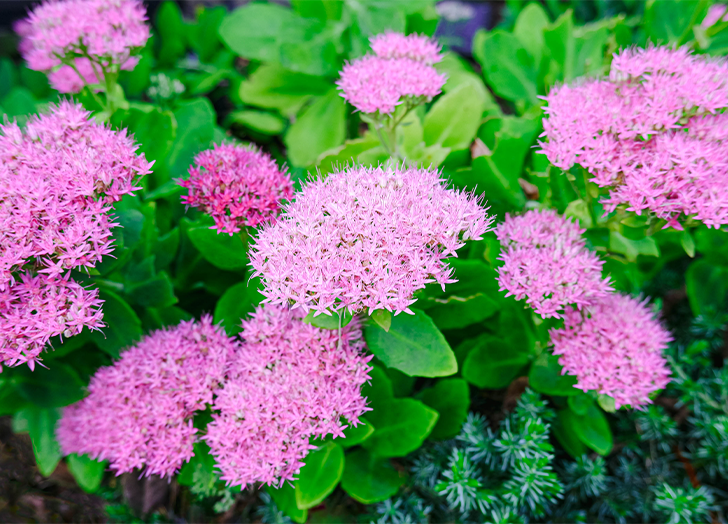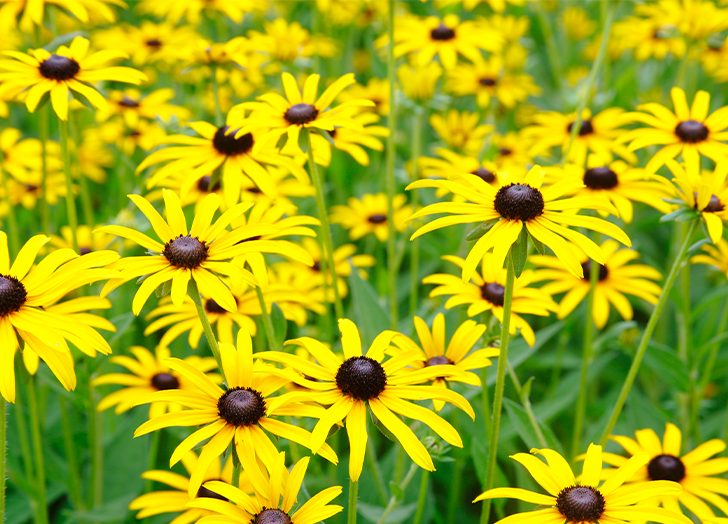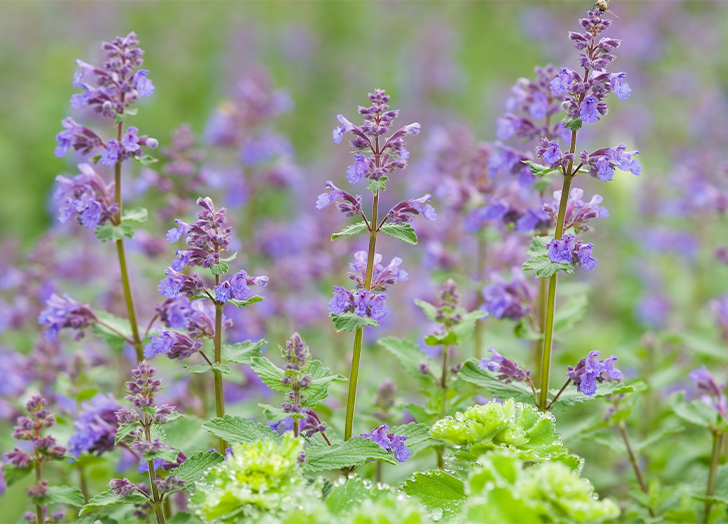29 Types of Perennials That Come Back Every Year

Perennials—aka plants that come back every year—are a gardener's dream. Not only are they pretty fixtures for your backyard, but once planted, you can look forward to their gorgeous blooms for years to come without the back pain. Even more appealing is the fact that most of them are quite hardy and low maintenance, which means they can survive under the dreariest weather conditions, and you don’t have to tediously water, prune or re-pot once they’re established. Below, check out 29 types of perennials you can incorporate into your garden—from over-the-top tall blooms to dainty, groundcover plants.
RELATED: 10 Shrubs You Should Never Prune in the Fall

1. Peonies
One of the most popular flowers around, it’s no wonder peonies have a dedicated following. These beauties are not only a sight for sore eyes, but they’re some of the longest-living perennials. (Some, according to Almanac, have been known to live 100 years). They’re low maintenance—just put them in a spot that gets about six to eight hours of sun and plant them away from trees or shrubs so they don’t have to compete for food, and watch those lush flowers come to life.

2. Foxglove
Tall and slender, foxgloves, aka Digitalis, are most commonly used as cottage flowers or on the back row of a flower border. These tubular flowering blooms are a little temperamental, so it’s important to take special care of them during the brisk winter months if you want them to bloom year after year. But don’t despair if they don’t come back after year two. Even under the care of the most diligent green thumb, these finger-like flowers are still one of the shorter-lived perennials around. P.S. Their eye-catching flowers may be hard to resist, but foxgloves can be toxic and are to be handled while wearing gloves and be planted where children and pets can’t reach.

3. Lavender
Another wild favorite, lavenders are super popular because not only are they pretty and versatile—lavender tea, soap or shampoo anyone?—but these nifty flowers also live for a long, long time, we’re talking 15 years in a home garden. Because they originated in the Mediterranean, you need to give these purple beauties tons of sunlight and well-drained soil because they are not fond of the shade or wet roots.

4. Yarrow
If you’re looking for a unique-looking plant to add to your garden, look no further than yarrow. These flowers grow in tiny clusters of yellow, red, pink or mixture of the three shades. Aromatic and remedial, yarrow has also been used for its healing properties. Plus, the teensy flowers are pest- and drought-resistant, and they also attract butterflies.

5. Daylily
Though they share the same name as lilies, daylilies are not, in fact, of the same genus. Where lilies are a little bit more temperamental, daylilies don’t require much to ornament your garden. Their fiery presentation will come through as long as you plant them in a hole with plenty of space for their roots to spread out and provide them with about an inch of water per week once established. Other than that, come hell or high water, these perennials will survive.

6. Sedum
If you’re on the market for a flower that gives you a creeping or low-growing option, you should definitely be looking at the sedum. Variations such as sedum divergens and sedum ternatum are creepers, which means you can plant at the edge of a balcony or by a fence for added pizazz. Others such as the low-growing sedum mojave and sedum murale are suited for ground cover.

7. Salvia
Also known as sage, these electric blue plant is beloved by the birds, the bees and butterflies too. Not only can it liven up your summer garden, but because it can grow to be as tall as five-feet tall (depending on the variety) it makes great cutting flowers too. Prop salvia on your dinner table, windowsill or front porch. It's heat and drought tolerant, which is a major plus.

8. Coneflower
You may have seen these beauties in a mound at your favorite park and even played “He loves me, he loves me not” while picking their lanky petals. That’s because coneflowers are as alluring as they are ubiquitous. The purple variety is most known, but there are also pink, red, orange, white, yellow and green varieties.

9. Columbine
Though it’s winter hardy, the columbine is yet another short-lived perennial, rarely making it to four or five-years-old. Columbines are dainty and delicate and should not be planted near plants that have excessive root growth. (Sorry, daylilies). Fun fact: These delicate shrubs have had a slew of interesting nicknames over the course of time. From milder ones such as bell flower to more interesting names such as elf shoe, fool’s cap, gipsy bell, devil’s clock and even god’s hat.

10. Hellebore
Commonly known as Lenten rose, the hellebore is an early-blooming flower that’s sure to make your winter blues a little bit better. These leathery flowers come alive between February and May, which is when they’ll need plenty of hydration. You can take it easy during the summer months because they go dormant. Plant these babies with snowdrops, daffodils and bleeding hearts for an illustrious garden.

11. Asters
Nothing will put a smile on your face quite like a cluster of asters lined up in a row. These daisy-like perennials keep those end-of-summer blues at bay as they’re known to bloom in the late summer and early fall months. While they don’t need much when it comes to maintenance, you do have to be a bit meticulous when handling them. Make sure you water at the base and not on the foliage, use organic mulch which can hold moisture, fertilize with balanced plant food and you’ll be good to go.

12. Black-Eyed Susan
With long stems, bright yellow petals and a dark middle, the difference may be hard to spot, but no, black-eyed Susans are not sunflowers. Black-eyed Susans have smaller discs in the middle of their flowerheads, while sunflowers have larger, flatter discs. Sunflower leaves are also wider (and coarse to the touch), whereas black-eyed Susan leaves are narrower. The biggest difference of course, is that you cannot roast and snack on black-eyed Susan seeds, while sunflower seeds have a slew of benefits.

13. Creeping Thyme
For those who want to replace that backyard lawn with a prettier plant, creeping thyme is a great place to start. This tricky little plant needs at least one year in order to get established, but once that second year comes around, it starts to spread, and nothing is ever the same. You can even plant this ground shrub over steppingstones or pavers. Bonus point: It’s as edible and aromatic as the thyme you use to season your food.

14. Siberian Iris
Unlike foxgloves and columbines, which don’t live long, you can plant some Siberian irises and relax knowing they’ll rebloom for years to come. These petite frills are widely known for having beautiful foliage, even after the blooming period is over. Dainty as it may be, Siberian iris spreads pretty wildly, so consider planting it in a spot that has plenty of room.

15. Catmint
Not to be confused with catnip—though strikingly similar—this bushy plant is not as attractive to our feline friends. It is, however, an excellent insect repellent, so feel free to plant it in the same vicinity as your vegetables. Catmint can thrive in the sun or partial shade as long as it’s sitting in well-draining soil.

16. Bee Balm
Aptly named, this spiky plant is a must-have in pollinator gardens because it’s very attractive to…well, bees, but also butterflies and hummingbirds. Nicknamed “wild bergamot,” bee balm is a member of the mint family and is edible. It can be used in herbal teas, salads and as garnishes. Plant these bright flowers under full sun to get their fullest glory.

17. Thrift
It may be a slow grower, but this plant has an elegant and graceful look to it once those pink, red or white blooms start coming to life. Native to coastal climates in Europe and North America, thrift plants can survive in harsh, rocky conditions, droughts and even drying winds.

18. Geranium
One thing every green thumb absolutely lives for is a beautiful bloom with diversity, and geraniums are just that. You can plant these flowers in your garden, have them as hanging plants or grow them indoors, they’ll thrive in each setting. Sidenote: If you’re going to grow them indoors, just make sure you place them in a spot where they’ll have plenty of lighting.

19. Allium
Reminiscent of dandelions, alliums are kin to onions, shallots and garlic, but a lot less delicious (like, not at all edible) and way more pretty to look at. Ornamental alliums are quite hardy and can be left untouched and will still grow in the same area for years. Oh, and BTW, alliums are not dog and cat friendly, so keep your four-legged friends away from them.

20. Balloon flowers
Feast your eyes on these star-shaped flowers that are as hardy as they are awe-inspiring. You can plant balloon flowers in border gardens or rock gardens, and they’ll perform just fine. While they’re not super spreaders, they will self-sow, which means you’ll end up with way more than you initially planted.

21. Coral Bells
Plant these in your garden alongside your driveway or backyard pathway and trust us, your friends will be asking about them. Coral bells are unique-looking perennials that have both a flower mound and flower stalk that can grow to be 12 to 36 inches tall. They can grow under different lighting conditions from full sun to full shade—just make sure you give them adequate water in that first year.

22. Roman Chamomile
Sure, it’s cool to have a pretty plant. You know what’s cooler? Having a pretty plant that is also medicinal. Of course, we’re not saying you go to your local nursey and bulk up on all the roman chamomile you can get your hands on, but it’s good to know that those pretty flowerheads can be used to make medicine that mitigates conditions such as indigestion, nausea, vomiting, loss of appetite, and intestinal gas and more, says RX List.

23. Penstemon
Think of the driest, most gravelly and barren patch of land in your garden, that’s exactly where you should plant penstemons and eliminate that eye sore. They may appear dainty, but these plants are quite resilient, most beloved for the fact that they can grow in the toughest conditions. Penstemons don’t require a lot of water, nor do they mingle well with enriched soils—talk about low maintenance.

24. Lamium
Need a plant that eliminates weeds on your behalf? Then go with the lamiums. These versatile groundcover plants prefer to grow in full or partial shade, so you can plant them under trees or shrubs. Their teeny pink flowers first bloom in the spring, but don’t be surprised when they disappear because they come and go until the fall months.

25. Chrysanthemums
Try saying that mouthful three times. If you can’t, then just opt for “mums” as they are commonly referred. These bright florals come in every pastel you could ever want—yellow, lavender, pink, purple, red, bronze, orange and white. Unlike other plants mentioned prior, mums need a fair amount of TLC. To get the best out of your flower, make sure you add mulch to keep the soil moist and ward off weeds, fertilize them monthly and make sure they’re getting adequate air circulation.

26. Tickseed
Gardeners love this sunny flower for its ability to grow in any type of garden soil and maintain a long-blooming season. While the yellow-hued tickseeds are most common, some also grow elegant pink blossoms or bicolored-blossoms that have a different color at their center. It’s no wonder butterflies, bees and birds are attracted to them.

27. Bleeding heart
They’re not as melancholy as they sound, we promise. They are, however, as fascinating to look at as their name suggests. These shade-loving plants got their intriguing name from their heart-shaped flowers, that hang quite like a heavy heart. To get the maximum effect of their unique appearance, make sure you’re consistently watering them and keeping them away from direct sunlight.

28. Elephant’s ear
If you’ve packed your garden with a ton of colorful florals and need a little bit of balance, you can add some contrast with this leafy plant that’s renowned for its large foliage. Elephant’s ear, aka, taro huge heart-shaped leaves that can grow anywhere between three to eight feet tall once they mature. They’re also a great add-in at the last minute since they’ll reach their full size within two months.

29. Bear’s Breeches
Once established, this handsome, structural plant is super tolerant of dry shade conditions. It produces large, oakleaf-shaped foliage and spikes of white-lilac flowers and can be quite aggressive, so make sure you plant it with adequate room to spread out.
RELATED: 19 Winter Plants to Add Color to Your Yard (Even During the Dreariest Days of the Year)
PureWow may receive a portion of sales from products purchased from this article, which was created independently from PureWow's editorial and sales departments.


